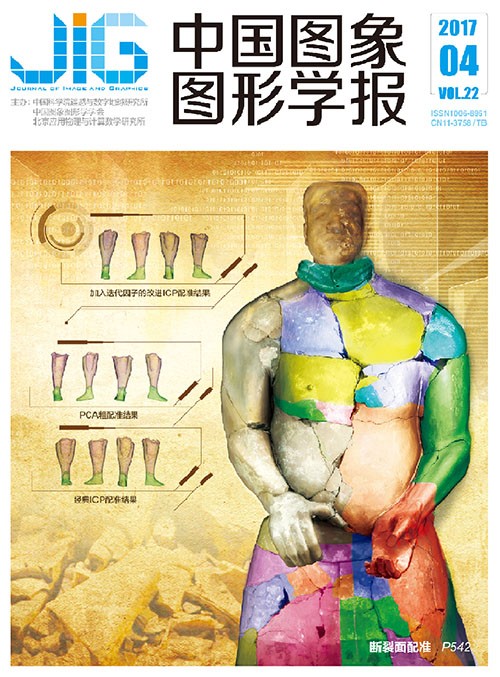
加入迭代因子的层次化颅骨配准方法
摘 要
目的 在基于知识的颅面复原中,为了对未知颅骨的面貌进行复原,需要在颅骨库里寻找相似颅骨,将相似颅骨的面皮作为参考。寻找相似颅骨的过程即颅骨配准,配准的精度和效率是两个重要性能指标。本文提出一种基于特征区域和改进ICP(iterative closest point)算法的层次化颅骨配准方法。方法 首先,将颅骨模型去噪、简化并归一化,通过计算体积积分不变量,确定每个点的凹凸性;使用K-means方法,将颅骨上的点聚类为多个或凹或凸的特征区域。然后,通过主成分分析法来计算两个颅骨的相似特征区域,对每一个可能的匹配计算3维变换,将两个颅骨粗略对齐;最后,采用加入迭代因子的方法对ICP算法进行改进,使用改进的ICP算法对颅骨进行精配准。结果 将本文方法用于颅骨模型、兵马俑模型以及公共数据集中的3维模型配准,经典ICP算法的配准时间分别为6.23 s、7.61 s、4.17 s,改进的ICP算法配准时间分别为3.02 s、3.23 s、2.83 s,算法效率提高了约2倍,配准效果也有明显提高。实验中通过对迭代因子的测试,发现不同的数据集需要设定不同的迭代因子。结论 本文所提出的基于区域特征的层次化配准方法提高了颅骨配准的精度和效率,整个过程不需要人工干预,该算法具有一定的普适性,可用于相似3维模型配准。
关键词
Hierarchical skull registration method with an iterative factor
Zhu Lipin, Liu Xiaoning, Liu Xiongle, Lu Yanning(College of Information Science and Technology, Northwest University, Xi'an 710127, China) Abstract
Objective Restore the appearance of an unknownskull during a craniofacial reconstruction procedure based on knowledge, the most similar skull should be retrieved from the database. Then, the reference face can be found according to the most similar skull. The process of searching for the most similar skull is called skull registration. In the skull registration problem, accuracy and efficiency are the two important performance targets that cannot be disregraded. A novel method for skull registration based on feature region extraction and the modified iterative closest point (ICP) algorithm is proposed in this study. The novel method is called the hierarchical skull registration method with an iterative factor.Method First, the skull model is denoised, simplified, and normalized. Then, the convexity or non-convexity of each point in the point cloud model is determined using the method based on an integral invariant. The surface of the skull can be divided into concave or convex feature regions via the k-means clustering method. The similarity of the concave or convex regions between two different skulls is subsequently calculated by comparing their principal components and areas. Optimal matching is conducted through exhaustive search. The optimal 3D transform for each potential pair of matched feature regions approximately aligns the skull surface. Lastly, the novel ICP algorithm with an iteration factor is applied to achieve fine registration.Result The presented method is applied to the skull registration of a Terracotta Army model and a public data set. The registration time of the classical ICP algorithm is 6.23 s, 7.61 s, and 4.17 s, whereas that of the improved ICP algorithm is 3.02 s, 3.23 s,2.83 s, respectively. Registration efficiency is doubled and accuracyis also significantly improved. However, the iteration factor varies for different data sets. Conclusion Experimental results show that the proposed algorithm can achieve better registration accuracy and higher iterative convergence speed in the fine registration stage.The entire process is completed without human intervention and demonstrates certain adaptability. It can be used for similar 3D model registrations.
Keywords
skull registration feature regions integral invariant principal component analysis modified iterative closest point(ICP)algorithm iteration factor
|



 中国图象图形学报 │ 京ICP备05080539号-4 │ 本系统由
中国图象图形学报 │ 京ICP备05080539号-4 │ 本系统由